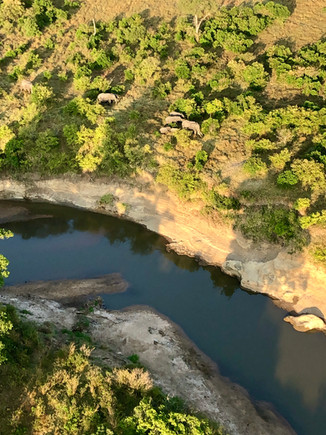Magical Maasai Mara
- ecemuratoglu@gmail.com

- Oct 12, 2020
- 7 min read
Maasai Mara is the largest national wildlife reserve in Kenya, it is connecting to the Serengeti National Park in Tanzania. Every year thousands of people visit Mara to see the famous big five - the lion, leopard, rhino, elephant, and African buffalo. The Great Migration, one of the Seven Natural Wonders of Africa, happens in Serengeti and Mara every year. More than one million wildebeests and 200,000 zebras make a loop between Tanzania and Kenya, here is a great short video by National Geographic and the story of the migration by Timbuktu Travel.
Since my partner and I moved to Kenya, we waited for some of our friends or family to visit us so that we go to Maasai Mara with them. By the time we had visitors, we were not able to take some days off from work, so we kept waiting for the next visitors. But the pandemic happened. And due to COVID-19, as of March, travel within the country was banned. And with all the changes happening in our life, it became clear that we would leave Kenya as soon as the international borders reopen. So we decided to go to Mara as soon as the travel ban within the country gets lifted to make sure we do not skip it. Finally, the ban got lifted in July. We made our trip to Mara towards the end of July when the migration started. From Nairobi to Mara, the road is about 5 hours. Due to COVID-19, there were fever-control points at the county borders.

We left Nairobi around 6 am and we reached our camping around midday. We stayed at the Oseki Maasai Mara Camp; it is a budget camping owned by Maasais, very close to the Maasai Mara National Reserve gate. At the camp, there are small ensuite bungalows which are quite comfortable, and there is also a camping option, of which I am not sure if you have to bring your tent or if they can rent one. As in most, if not all, lodges, food is inclusive in stays. The breakfast at Oseki was simple, fresh, and delicious. It’s a typical Kenyan breakfast with eggs, sausages, beans, some fruits, tea, coffee, and enough bread for everyone. Lunch and dinner were typical Kenyan food as well, delicious sukuma, some carbs as a side dish, soup, some chicken, and more. Most important, the service was great. The guys at the camp are lovely, smiling, and great at hospitality. They always had cold beers – which is good because Kenyans do not drink beer cold. We paid 5,500 KSH per night per person. Overall it was a good experience. Sure, if you are looking for a more luxurious stay, I would not recommend Oseki. But if you are in more for the local culture and a laidback place, Oseki is ideal.
When in Mara, days start early. By 6 am, we were at the reserve gate. As soon as the park is open, the game drive starts. Maasai Mara has different fees for Kenyans, residents, and non-residents. When you are a resident, it is about 1,200 KSH per person. But when you are a non-resident tourist, it is 70 USD per person. This is 7 times more than the resident price. On average, Maasai Mara receives about 300,000 visitors in a year some sources say. This year, because of the pandemic, the reserve did not get any visitors. So we were lucky to be living in Kenya and having the chance to go to Mara when no non-resident tourists are coming. We enjoyed the silence.
Some people stay more than two nights, but to me, it was enough that we had 3-days, 2-nights planned for Mara. Sure, one of the reasons is that it was not my first safari trip. I have been to Samburu and Amboseli before. Maybe for a first-timer, it might be meaningful to stay longer in Mara.
On our first day, we reached the camping around lunchtime. We rested in the beautiful sunset point of our camp, enjoyed lunch, and went to our first game drive. We saw so many lions to start with, Mara welcomed us well. Following that, we saw elephants, giraffes, buffalos, hyenas, zebras, gazelles. Our main goal was to see the famous river-crossing of wildebeests. However, that was the plan for the upcoming days. Spending all afternoon in the safari van, standing up, watching the animals, and going from places to places in the car is surprisingly tiring. We went back to camping to catch the sunset; it was beautiful!

On the second day, our focus was to see the river-crossing. The crossing happens on the Mara River; this is where the wildebeest, zebras, and gazelles are coming from Serengeti/Tanzania to Maasai Mara/Kenya for fresh forage. It is luck to see them crossing the river. The Mara River from Oseki is about a 1-hour drive. You can take a neck pillow in your safari car to keep sleeping until you reach the river; at least I did so. At the river, we saw a lot of zebras, wildebeests, and gazelles; they were not crossing it. But we see them migrating for sure, because they were all marching one by one following each other, and they were countlessly too many! Those are the two signs of migration for me. In the end, I did not see them crossing the river, but so what? I saw them everywhere. And they are so loud and funny!
The same day we had a bush lunch in the middle of nowhere, but very near the Tanzania border. There is this rock indicating the border. So, if you go a little further, you are basically in Tanzania, though I do not know if anybody cares.
After lunch, we kept going on the game drives, and we saw more of all the animals, elephants, giraffes. The only animal I could not get the chance to see during my time in Kenya is the leopard. The one I wanted to see the most, but never had the opportunity except the one time in Samburu! It makes me sad to remember that unfortunate car problem. This time, at least I saw the lunch leftovers of a leopard hanging on the tree.

The third day was the long-awaited birthday gift day for me. For my birthday earlier in the year, I received the greatest gift of all times: a hot air balloon tour over Maasai Mara! That was a collective gift from my friends and boyfriend. Only three companies are doing the hot air balloon in Maasai Mara, and one of them is the Fig Tree Camp. Since there were not many tourists in Mara, there was no demand for the balloon either. We were only three people willing to go on the trip, so Fig Tree put some sandbags and invited some of their staff to come to the tour because there needs to be enough weight for the balloon to take off. Our pilot was a cool Kenyan man. He was fun and experienced. For the balloon, we had to be there around 5 am. It is a whole experience of blowing the balloon, taking off, having an hour in the air, landing, and finishing with a great breakfast in the bush with a lot of prosecco. I have done the hot air balloon in Capadoccia before, and the scenery there was fascinating as well. But in Mara, it is a whole different story with all the wild animals beneath. The sunrise was poetic. And giraffes running on the land was like a slow-motion video. We saw a lot of hippos in the river, an elephant family taking a walk, and giraffes just hanging around. Flying over the Mara felt purely free, endless, happy, and full of life. I was sad when the flight was over. I wished it could last longer. Fortunately, this incredible trip ends with breakfast with prosecco. So I increased the euphoria of the balloon tour with glasses of prosecco. And that was the happiest morning of all my time in Kenya.
Happy Ece doesn't know how to pose:
After the balloon tour, we continued our day in the reserve, surrounded by countless wildebeests and zebras. Oseki team prepared lunch boxes for us since we had to leave Mara around midday to be back in Nairobi on time. Due to curfew at 7 pm, the drivers had to drop us back to our places latest by 6 pm.

Maasai Mara is an expensive destination when you do not live in Kenya or any of the neighboring countries. But Kenya has a lot to offer other than Mara: the coast, the lakes, and the culture. This beautiful country worths a long trip. And I hope the ones who are dying to see this beauty will get the chance to visit.
A few disturbing facts on Maasai Mara:
🦁In Maasai Mara, the safari cars are allowed to drive off-road, which means that you can get close to the animals, very close, like the lion Picture next to our car. It is joyful for the tourists, but not helpful for wildlife. I read in some articles that this sometimes prevents animals from hunting and ruins their daily natural life. In Amboseli and Samburu, this is not the case. Cars have to stay on the roads. Respect for the wildlife!
🦁All the safari drivers communicate with each other when there is some unique incident to see, which is again great for visitors because you get to see that unique thing going on. However, this brings too many cars together at a spot, and it is ruining the moment. The sound of the engines interrupts the animals.
🦁Safari cars are very open, with no roof, no windows. Some visitors do not pay attention, and their trash flies out from the vehicles. That was super annoying to see.
A few useful tips to keep in mind when going to safari:
🐘Get binoculars, they are necessary
🐘When you leave your warm bed in the early morning, it’s cold. So you will be wearing some warm clothes. But take a bag with you where you have sunglasses, a pair of flip flops, a hat for the sun, sunscreen lotion, a t-shirt, and shorts. Long sleeve loose shirts are helpful to protect yourself from the sun.
🐘Most safari vehicles have plugs! So you can bring your charger. Also, if you have, take your spare battery to charge your phone.
🐘A neck pillow is great when going on a long drive in Kenya. And in Mara, it definitely makes a difference.
Until next time Mara!♥️







































































Comments